Hi everyone,
I have an old-model (1960?) Quad II mono-amp with control unit and MW/SW/LW tuner, which was working fine about 20 years ago, including the green cat´s eye tuning monitor. It went into "safe" storage for a number of years, next to the garage, but a rainstorm 2 years ago caused a leak in the roof, with water dripping heavily onto the set. I only discovered that long after it had dried out.
When I tried it out recently, all the valve filaments did light up very nicely, but the set didn´t work. The volume control crackles loudly and amp output is very noisy, even with all possible filters set. Each time, the set only works for a short while until it stops. The tuner only receives one AM station (v. faintly) and the green cat´s eye won´t work either.
Then I tried it out only the amp and the control unit, connecting the earphone plug of an old cassette player to one of the AUX inputs, but output is noisy with very faint signal.
Opening the three modules to look inside, I didn´t really see anything I could understand - I don´t really know what to look for, although I do have all the documentation, manuals and electronics schematics.
I wonder if it will be possible to try and save this set, or if it will be worth the trouble, and would appreciate any possible comments to this respect.
I´ve seen some threads here related to Quad II repair, but I can´t tell if the repair-work done there would apply to my case.
At the moment, I´m trying to get a video and a photo out of my mobile phone to attach to this message as illustration for the previous paragraph.
Cheers for now, and thanks in advance!
Aleatorylamp
I have an old-model (1960?) Quad II mono-amp with control unit and MW/SW/LW tuner, which was working fine about 20 years ago, including the green cat´s eye tuning monitor. It went into "safe" storage for a number of years, next to the garage, but a rainstorm 2 years ago caused a leak in the roof, with water dripping heavily onto the set. I only discovered that long after it had dried out.
When I tried it out recently, all the valve filaments did light up very nicely, but the set didn´t work. The volume control crackles loudly and amp output is very noisy, even with all possible filters set. Each time, the set only works for a short while until it stops. The tuner only receives one AM station (v. faintly) and the green cat´s eye won´t work either.
Then I tried it out only the amp and the control unit, connecting the earphone plug of an old cassette player to one of the AUX inputs, but output is noisy with very faint signal.
Opening the three modules to look inside, I didn´t really see anything I could understand - I don´t really know what to look for, although I do have all the documentation, manuals and electronics schematics.
I wonder if it will be possible to try and save this set, or if it will be worth the trouble, and would appreciate any possible comments to this respect.
I´ve seen some threads here related to Quad II repair, but I can´t tell if the repair-work done there would apply to my case.
At the moment, I´m trying to get a video and a photo out of my mobile phone to attach to this message as illustration for the previous paragraph.
Cheers for now, and thanks in advance!
Aleatorylamp
Last edited:
That really depends how bad the water damage is. Impossible to second guess at a distance and without pictures.I wonder if it will be possible to try and save this set, or if it will be worth the trouble, and would appreciate any possible comments to this respect.
There are a lot of possible areas that could be misleading here. Ideally you need to feed a known good signal into the amp of known amplitude (from a signal generator or test CD etc) and that gives you something definite to work with. An oscilloscope is really called for to look at what is happening and to trace the signal.Then I tried it out only the amp and the control unit, connecting the earphone plug of an old cassette player to one of the AUX inputs, but the same happened.
Radio receivers with their very precisely aligned and tuned circuits will be highly susceptible to liquid damage and depending how bad it is may well be not economically repairable. Repairing and aligning tuners is highly specialised and requires a different skill set and test equipment to do it properly.The tuner only receives one AM station (v. faintly) and the green cat´s eye won´t work either.
In the end it all depends how bad the damage is.
Hi Aleatorylamp,
Worth repair - absolutely!
Build it in stock form. Parts will fail in storage, water or no. Water may complicate things, like any contacts. It may also leave residue that can be conductive. I have rebuilt many, but done right. Improperly restored equipment is a bear to put right, so costs more than it would have. Plus, damage can be caused. Both cosmetic and electrical.
When you have equipment stored a long time, in years, NEVER PLUG IT IN!!!! Increase the supply voltage slowly with a variac. That allows the capacitors to reform without causing a short. Or, it there is a fault you can limit current flow to prevent reduce damage. A dim bulb is better than plugging it in, but still not correct.
Worth repair - absolutely!
Build it in stock form. Parts will fail in storage, water or no. Water may complicate things, like any contacts. It may also leave residue that can be conductive. I have rebuilt many, but done right. Improperly restored equipment is a bear to put right, so costs more than it would have. Plus, damage can be caused. Both cosmetic and electrical.
When you have equipment stored a long time, in years, NEVER PLUG IT IN!!!! Increase the supply voltage slowly with a variac. That allows the capacitors to reform without causing a short. Or, it there is a fault you can limit current flow to prevent reduce damage. A dim bulb is better than plugging it in, but still not correct.
Hi Anatech and Mooly,
Thanks for your replies. I was going to give this set to a friend, but it doesn´t work properly, so I´m trying to see if I can fix it first, but without an oscilloscope, I´m afraid. I might even keep it at the end... 😎
Before I go any further, I´ll post a pic and a video first.
OK, here they are attached now.
I thought it was worse, but apparently it IS doing something, so whatever the noises are, it may be fixable and not too complicated.
Can anything be deduced from the video?
Tomorrow, I´ll try and open the modules again and send some pictures of the innards, to see if something can be identified.
BTW, the band-aid on my wrist was our cat - no hospital catheter...
Thanks again, in advance.
More, later.
Cheers,
Aleatorylamp
Thanks for your replies. I was going to give this set to a friend, but it doesn´t work properly, so I´m trying to see if I can fix it first, but without an oscilloscope, I´m afraid. I might even keep it at the end... 😎
Before I go any further, I´ll post a pic and a video first.
OK, here they are attached now.
I thought it was worse, but apparently it IS doing something, so whatever the noises are, it may be fixable and not too complicated.
Can anything be deduced from the video?
Tomorrow, I´ll try and open the modules again and send some pictures of the innards, to see if something can be identified.
BTW, the band-aid on my wrist was our cat - no hospital catheter...
Thanks again, in advance.
More, later.
Cheers,
Aleatorylamp
Attachments
Last edited:
Hi Aleatorylamp,
You know, there is only one way to "fix" (repair) something. The right way. Say you get it making noise, then later it burns up. That's a sad loss. That and your friend ends up with nothing.
I would respectfully say that you have two reasonable options. First, either you or your friend pays to have it repaired properly (you need equipment). That way it runs properly and lasts. Second, sell it to someone who can fix it properly and either keep the money or give it to your friend.
Some things really do need skill and experience to do. That means installing the parts it needs instead of doing it the least expensive way possible. The proper parts. Keep in mind this is tube equipment, and modern resistors are rated lower in voltage breakdown than old carbon comp resistors (500V vs as low as 50V for some) You must know your parts as a bare minimum! I would love it if you were able to rebuild it properly, but it is a classic and deserves to be repaired properly. I hope you can see that.
You know, there is only one way to "fix" (repair) something. The right way. Say you get it making noise, then later it burns up. That's a sad loss. That and your friend ends up with nothing.
I would respectfully say that you have two reasonable options. First, either you or your friend pays to have it repaired properly (you need equipment). That way it runs properly and lasts. Second, sell it to someone who can fix it properly and either keep the money or give it to your friend.
Some things really do need skill and experience to do. That means installing the parts it needs instead of doing it the least expensive way possible. The proper parts. Keep in mind this is tube equipment, and modern resistors are rated lower in voltage breakdown than old carbon comp resistors (500V vs as low as 50V for some) You must know your parts as a bare minimum! I would love it if you were able to rebuild it properly, but it is a classic and deserves to be repaired properly. I hope you can see that.
Hi Anatech,
My friend is English, and actually said the same thing, that this is a classic and deserves to be repaired properly, but unfortunately the only person he knows here only does old computers (from the 90´s at best). However, I may be able to ask an old technician here, who changed the lazer on a Techniks CD player for me some years ago - although that would still be too modern!
It´s not like in Canada or England, where you could meet people who appreciate or even know about this kind of equipment.
So it isn´t a matter of just diving in, changing some caps and resistors... Hmmmm...
Will it be worth my opening the modules again and sending photos of the innards maybe tomorrow, or is that just a waste of time?
Cheers,
Aleatorylamp
My friend is English, and actually said the same thing, that this is a classic and deserves to be repaired properly, but unfortunately the only person he knows here only does old computers (from the 90´s at best). However, I may be able to ask an old technician here, who changed the lazer on a Techniks CD player for me some years ago - although that would still be too modern!
It´s not like in Canada or England, where you could meet people who appreciate or even know about this kind of equipment.
So it isn´t a matter of just diving in, changing some caps and resistors... Hmmmm...
Will it be worth my opening the modules again and sending photos of the innards maybe tomorrow, or is that just a waste of time?
Cheers,
Aleatorylamp
This equipment is around 65 years old. Imagine trying to restore a car that old found in a barn with a leaky roof.
Hi Rayma!
I was only 8 when it was built - I get your point.
Incidentally, I was at a greenhouse out in the country yesterday to get some potted plants, and the people had two 1972 Citroen DS-21 cars rusting away in their parking lot. "You can have them, if you like" they said...
Anyway...
I was only 8 when it was built - I get your point.
Incidentally, I was at a greenhouse out in the country yesterday to get some potted plants, and the people had two 1972 Citroen DS-21 cars rusting away in their parking lot. "You can have them, if you like" they said...
Anyway...
Hi Aleatorylamp,
Okay, I get it.
No great options. What equipment do you have? You need a good DVM, you really should have an oscilloscope for later. Can you get access to anything like this?
You want a soldering station good for at least 40 watts. A 25 (40 slightly better - too hot) watt uncontrolled pencil will not cut it. Desoldering tool, the big ones, not the little one hand pump thing (useless). From experience, most resistors are out of tolerance, replace all capacitors. The box type can (main filter capacitors) be replaced with a dual capacitor, but mounted on supports. Don't glue the thing! Replace with the same values, 20 uF or 32 uF max for the dual filter capacitor unit.
Take many digital photos !!!! Remove the parts including all leads, don't "snip and tack"! Install the new parts to look the same as the ones you removed. Use axial capacitors, not radial for the coupling capacitors.
Okay, I get it.
No great options. What equipment do you have? You need a good DVM, you really should have an oscilloscope for later. Can you get access to anything like this?
You want a soldering station good for at least 40 watts. A 25 (40 slightly better - too hot) watt uncontrolled pencil will not cut it. Desoldering tool, the big ones, not the little one hand pump thing (useless). From experience, most resistors are out of tolerance, replace all capacitors. The box type can (main filter capacitors) be replaced with a dual capacitor, but mounted on supports. Don't glue the thing! Replace with the same values, 20 uF or 32 uF max for the dual filter capacitor unit.
Take many digital photos !!!! Remove the parts including all leads, don't "snip and tack"! Install the new parts to look the same as the ones you removed. Use axial capacitors, not radial for the coupling capacitors.
Hi Anatech,
Many thanks for your solid-sounding information!
I thought only some parts would have to be changed, but couldn´t figure out which, but it seems to be a case perhaps just as or not quite as complicated as toniburner´s "Yet Another QUAD II Restoration", although in my case all the valves seem to be fine. Quite a big job, I must admit, including re-making the leads.
I need to get the tools you mention, as for the moment, all I have is an AVM (Analogue Volt Meter), a 40 Watt soldering gun and a 25 Watt uncontrolled pencil with a rotten hand pump thing.
So... I´ll start with opening the 3 modules again, this time taking loads of digital photos, and noting down the items to be replaced, and check our local electronic component store here for availability, and then take it from there. Anyway, I´ll try and post some pictures tomorrow.
It looks like there just might possibly be some luck floating in the air for the old Quad II !!
Once again, many thanks for your post!
Cheers,
Aleatorylamp
Many thanks for your solid-sounding information!
I thought only some parts would have to be changed, but couldn´t figure out which, but it seems to be a case perhaps just as or not quite as complicated as toniburner´s "Yet Another QUAD II Restoration", although in my case all the valves seem to be fine. Quite a big job, I must admit, including re-making the leads.
I need to get the tools you mention, as for the moment, all I have is an AVM (Analogue Volt Meter), a 40 Watt soldering gun and a 25 Watt uncontrolled pencil with a rotten hand pump thing.
So... I´ll start with opening the 3 modules again, this time taking loads of digital photos, and noting down the items to be replaced, and check our local electronic component store here for availability, and then take it from there. Anyway, I´ll try and post some pictures tomorrow.
It looks like there just might possibly be some luck floating in the air for the old Quad II !!
Once again, many thanks for your post!
Cheers,
Aleatorylamp
Hi Aleatorylamp,
Well, when you buy resistors you should get Metal Film types, 1 watt minimum (rated 350V and 2 watts are rated 450 to 500 V normally. These will also have longer leads and be closer mechanically to the originals, which you need. Small capacitors, use Polypropylene, may as well reduce distortion while you're at it. Good electrolytic capacitors, no Philips. Something name brand. You can find the dual filter capacitor under F&T or similar, usually 500 VDC rating. Be careful removing leads from tube socket pins, the leads are stronger than the terminal. Patience ! The other tag terminals can also be fragile. Just use patience and care.
These better components will not change the sound character except to reduce distortion. They used the best they had at the time, they were not trying to have any certain sound.
A soldering station is a joy to use. I can get nice ones from AliExpress for less than $100 Canadian, KSGER and a 3mm screwdriver tip for this. Smaller screwdriver tips will be useful for other jobs. You should get the tip thermometer as well to calibrate that and anything else you have like your 25 watt and gun. Just so yo have an idea of the temperatures they reach. Your 25 watt pencil is really a wood art iron. Not enough heat will cause a lot of trouble, especially for desoldering jobs. You'll probably over heat components trying to solder with it as well, believe it or not. The joint spends too much time hot but not hot enough to flow the solder properly.
Well, when you buy resistors you should get Metal Film types, 1 watt minimum (rated 350V and 2 watts are rated 450 to 500 V normally. These will also have longer leads and be closer mechanically to the originals, which you need. Small capacitors, use Polypropylene, may as well reduce distortion while you're at it. Good electrolytic capacitors, no Philips. Something name brand. You can find the dual filter capacitor under F&T or similar, usually 500 VDC rating. Be careful removing leads from tube socket pins, the leads are stronger than the terminal. Patience ! The other tag terminals can also be fragile. Just use patience and care.
These better components will not change the sound character except to reduce distortion. They used the best they had at the time, they were not trying to have any certain sound.
A soldering station is a joy to use. I can get nice ones from AliExpress for less than $100 Canadian, KSGER and a 3mm screwdriver tip for this. Smaller screwdriver tips will be useful for other jobs. You should get the tip thermometer as well to calibrate that and anything else you have like your 25 watt and gun. Just so yo have an idea of the temperatures they reach. Your 25 watt pencil is really a wood art iron. Not enough heat will cause a lot of trouble, especially for desoldering jobs. You'll probably over heat components trying to solder with it as well, believe it or not. The joint spends too much time hot but not hot enough to flow the solder properly.
I change everything in a Quad II except the main PSU caps; everything in a QC-II except the small capacitors on the switch bank; and practically nothing in the AM tuner unless it has red Hunts capacitors, which should be treated with grave suspicion. There is one resistor that can give trouble, the screen resistor R18, which goes high and reduces the gain. The tuner will probably still be in alignment, and probably has nothing more wrong with it than water. The noises you get sound like the three large electros in the QC-II and perhaps the 47uF cathode bypass cap: these are all mounted together under the top tagstrip.I thought only some parts would have to be changed, but couldn´t figure out which,
Hi Anatech,
Thank you very much for your for the further specific information on re-vamping the Quad-II amp.
For the 1st step, in order to take the first innards-photos of the Quad-II amp, I´m still freeing some space to clear the little workbench in my 2 x 2 meter spare-room corner I use as workshop/computer-room/storage-racks/workbench... Usually there´s hardly any space to swivel the chair around without bumping the knees with all that´s stacked around. A lamentable state of affairs, but I suppose it´s part of the fun.
This refurbishing job certainly won´t be a piece of cake, as you have already warned.
However, with patience and time as you say, I´m sure I´ll get there.
At least, I have a good head start, as all valves seem to be in good order!
Hi ejp,
Thanks! I was just going to post a question regarding precisely what you said you do with the Tuner and QC-II. Thank you very much indeed for this info.
By the way, there is no water in anything anymore, and it wasn´t connected or turned on during or after the rainstorm, but of course, water may have seeped in somewhere and dissolved something before drying out, but I wouldn´t know.
Anyway... as soon as I have cleared my workbench, I´ll open the units one after the other to post some pictures.
Cheers, and thanks again for all the counselling!
Aleatorylamp
Thank you very much for your for the further specific information on re-vamping the Quad-II amp.
For the 1st step, in order to take the first innards-photos of the Quad-II amp, I´m still freeing some space to clear the little workbench in my 2 x 2 meter spare-room corner I use as workshop/computer-room/storage-racks/workbench... Usually there´s hardly any space to swivel the chair around without bumping the knees with all that´s stacked around. A lamentable state of affairs, but I suppose it´s part of the fun.
This refurbishing job certainly won´t be a piece of cake, as you have already warned.
However, with patience and time as you say, I´m sure I´ll get there.
At least, I have a good head start, as all valves seem to be in good order!
Hi ejp,
Thanks! I was just going to post a question regarding precisely what you said you do with the Tuner and QC-II. Thank you very much indeed for this info.
By the way, there is no water in anything anymore, and it wasn´t connected or turned on during or after the rainstorm, but of course, water may have seeped in somewhere and dissolved something before drying out, but I wouldn´t know.
Anyway... as soon as I have cleared my workbench, I´ll open the units one after the other to post some pictures.
Cheers, and thanks again for all the counselling!
Aleatorylamp
Hi Aleatorylamp,
With care and attention you should be okay. As long as you work carefully. The old part doesn't need to survive, the tube sockets and terminals are valuable. Work accordingly. Some surface cutting cutters will be helpful since you can cut to the surface of a terminal. Normal diagonal cutters are more difficult in that situation, but they last longer in normal work.
Tools I have found extremely helpful were the two cutters I mentioned, plus heavy diagonal cutters. Needle nose pliers, and bent ones plus a pair of heavy needle nose pliers. I bought good tools and still have most I got as a teenager. Cheap cutters are a no-no. Use pliers to bend the leads so they fit. It is a form of art. Can be frustrating.
Hi ejp,
Excellent points.
I replace the main filter caps in Quad II amps. Remove the plastic name plate, drill the mounting holes for hex supports and countersink. Use flat head screws to fasten (M3) and replace the plate. Invisible. I use a multi-section cap saddle to mount the new dual capacitor. The leads then end up close to the same place and you don't have to disturb the harness at all. The filter capacitor is solidly mounted. Some folks pull the insides and rebuild that box capacitor, this costs too much unless your client is dead set on maintaining the internal appearance and is will to pay the extra. There really isn't any point in this.
From experience, all other resistors and caps are replaced as well. For one, it is easier, secondly they aren't as good as when they were new and will probably need replacement anyway in the future. Why save one or two parts?
With care and attention you should be okay. As long as you work carefully. The old part doesn't need to survive, the tube sockets and terminals are valuable. Work accordingly. Some surface cutting cutters will be helpful since you can cut to the surface of a terminal. Normal diagonal cutters are more difficult in that situation, but they last longer in normal work.
Tools I have found extremely helpful were the two cutters I mentioned, plus heavy diagonal cutters. Needle nose pliers, and bent ones plus a pair of heavy needle nose pliers. I bought good tools and still have most I got as a teenager. Cheap cutters are a no-no. Use pliers to bend the leads so they fit. It is a form of art. Can be frustrating.
Hi ejp,
Excellent points.
I replace the main filter caps in Quad II amps. Remove the plastic name plate, drill the mounting holes for hex supports and countersink. Use flat head screws to fasten (M3) and replace the plate. Invisible. I use a multi-section cap saddle to mount the new dual capacitor. The leads then end up close to the same place and you don't have to disturb the harness at all. The filter capacitor is solidly mounted. Some folks pull the insides and rebuild that box capacitor, this costs too much unless your client is dead set on maintaining the internal appearance and is will to pay the extra. There really isn't any point in this.
From experience, all other resistors and caps are replaced as well. For one, it is easier, secondly they aren't as good as when they were new and will probably need replacement anyway in the future. Why save one or two parts?
Another option you have is to put the amplifier on a well known auction site and let the buyer pay the delivery costs.
With original KT66s and GZ32, then you should be able to achieve a few hundred euros.
If you are unable to do a sympathetic job of the restoration, then the value plummets.
With original KT66s and GZ32, then you should be able to achieve a few hundred euros.
If you are unable to do a sympathetic job of the restoration, then the value plummets.
Hi Anatech,
Again, thanks for your attention and recommendations. I´m accumulating your comments on a separate text file to print it out!
Hi OldHector,
Thanks for your thoughts. I know too little about auctioning on the Internet, and my daughter, who´s a computer engineer, will probably skive...
Anyway, here is the first of three parts of Step One: Fourteen Quad-II pictures.
Some show rust, indicating where the water was dripping to and where it went, and others show some possibly cracked or damaged resistors, maybe.
The wiring seems OK, though, in my ignorant opinion...
I didn´t make the the picture resolution too high because I don´t know how much this thread can support...
Chgeers,
Aleatorylamp
Again, thanks for your attention and recommendations. I´m accumulating your comments on a separate text file to print it out!
Hi OldHector,
Thanks for your thoughts. I know too little about auctioning on the Internet, and my daughter, who´s a computer engineer, will probably skive...
Anyway, here is the first of three parts of Step One: Fourteen Quad-II pictures.
Some show rust, indicating where the water was dripping to and where it went, and others show some possibly cracked or damaged resistors, maybe.
The wiring seems OK, though, in my ignorant opinion...
I didn´t make the the picture resolution too high because I don´t know how much this thread can support...
Chgeers,
Aleatorylamp
Attachments
-
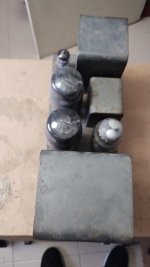 Quad-II-2.jpg87.7 KB · Views: 0
Quad-II-2.jpg87.7 KB · Views: 0 -
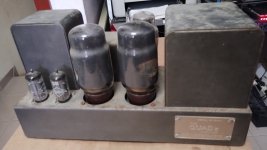 Quad-II-3.jpg106 KB · Views: 0
Quad-II-3.jpg106 KB · Views: 0 -
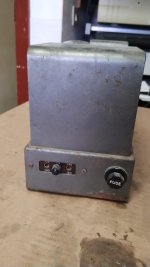 Quad-II-4.jpg105.4 KB · Views: 0
Quad-II-4.jpg105.4 KB · Views: 0 -
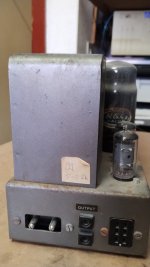 Quad-II-5.jpg144.7 KB · Views: 0
Quad-II-5.jpg144.7 KB · Views: 0 -
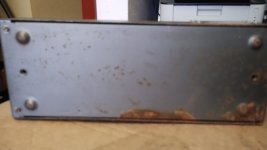 Quad-II-6.jpg51.3 KB · Views: 0
Quad-II-6.jpg51.3 KB · Views: 0 -
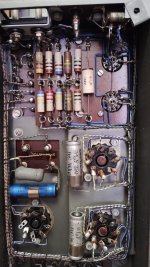 Quad-II-7.jpg263.9 KB · Views: 0
Quad-II-7.jpg263.9 KB · Views: 0 -
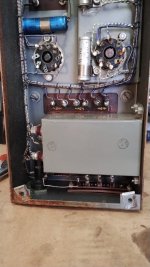 Quad-II-8.jpg193.3 KB · Views: 0
Quad-II-8.jpg193.3 KB · Views: 0 -
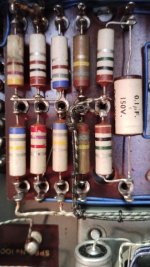 Quad-II-9.jpg180.5 KB · Views: 0
Quad-II-9.jpg180.5 KB · Views: 0 -
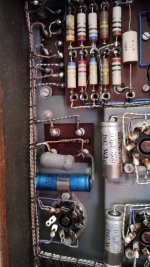 Quad-II-10.jpg201 KB · Views: 0
Quad-II-10.jpg201 KB · Views: 0 -
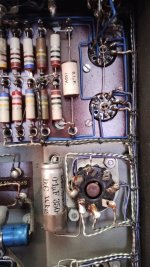 Quad-II-11.jpg246.5 KB · Views: 0
Quad-II-11.jpg246.5 KB · Views: 0 -
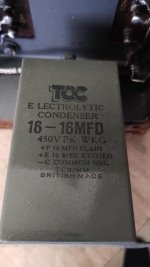 Quad-II-12.jpg102.8 KB · Views: 0
Quad-II-12.jpg102.8 KB · Views: 0 -
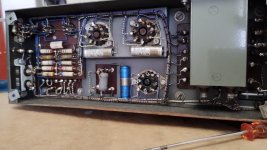 Quad-II-13.jpg176.4 KB · Views: 1
Quad-II-13.jpg176.4 KB · Views: 1 -
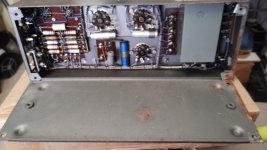 Quad-II-14.jpg156.7 KB · Views: 1
Quad-II-14.jpg156.7 KB · Views: 1 -
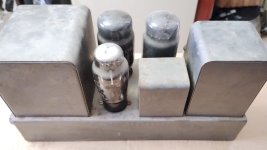 Quad-II-1.jpg105.6 KB · Views: 1
Quad-II-1.jpg105.6 KB · Views: 1
- Home
- Amplifiers
- Tubes / Valves
- QUAD II mono amp/control unit/tuner (old model-1960)
